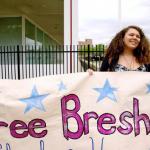Ruby Pinto on Art and Activism Working Together

Up next in our series of interviews with notable, in-the-know locals: Ruby Pinto, a member of For the People Artists Collective, which curated Do Not Resist? 100 Years of Chicago Police Violence, a city-wide exhibit opening at Hairpin Arts Center this Friday, January 12.
Can you explain what the exhibit is about?
The focus is on the past 100 years of police brutality in Chicago. In particular, we wanted to draw attention to the resistance that’s happened here. A lot of the pieces on display feature people who were victims of police brutality, but the show doesn’t focus exclusively on violence and harm. We’re not just looking at the moment when a victim was killed, but at their whole existence and the way they continue to stay with us.
What specific events from history does the exhibit cover?
Arella Vargas and I are doing a piece on the raids of the Industrial Workers of the World offices in 1917. The government said the raids happened because the union had violated the Espionage Act, but it was actually because IWW leaders were encouraging people not to enlist for World War I—prevalent anti-war messaging coming from a strong union.
The government wasn’t successful—they didn’t stop the union’s day-to-day operations—but they did arrest a lot of people. They went into private homes, they seized private property. More than 100 people were put on trial, and some were imprisoned for up to 20 years. Our message is that the government will do these things, especially under the current regime, but you have to use that moment to build more power.
How does the exhibit deal with prison and policing today?
Our collective shares the politics of prison and police abolition. When I think of those politics, I think of resource distribution. Our basic needs have to be met in order to be good community members. In Chicago, for example, schools are being closed in black and brown neighborhoods, and public housing is dwindling. Meanwhile, we look at the funding that the police and the state receive, and what they actually do with that funding. They’ve been terrorizing us with it; they’ve been further militarizing. For example, one piece in the show is about when the CPD received a helicopter in 1958, and what that meant for the people of Chicago.
Does the show offer visions of what police abolition might look like?
Absolutely. One of our exclusive goals was to make sure we weren’t engaging people and leaving them wondering what’s next. We’re going to have a whole resource center with printouts and zines and pamphlets about abolitionist theories, concepts, practices.
Some of the pieces also deal with abolition. One I’m excited about is by Tesh Silver, about Rekia Boyd, [the 22-year-old woman killed by an off-duty CPD officer in Douglas Park in 2012]. From what I understand, Rekia Boyd was a nurturer. She wanted to open a childcare center. So Tesh did a portrait of Rekia tending a garden with live flowers in it. To me, that is the beauty and the life that could exist if we didn’t have the police. Rekia could be here tending a garden, taking care of children.
In all of our conversations as a collective, we try to ask: What does community safety look like? What does abolition look like? As a collective of artists, we believe that art is crucial to building this future, because we don’t know what it looks like and we need to nurture our imaginations to envision it.
Tell me about the opening this Friday.
It’s going to feature a performance by Kuumba Lynx, a group of youth in Uptown that do spoken word and dance pieces. They wrote a half-hour piece for this exhibit. And the great-aunt of Pierre Loury, who was killed by the police two years ago when he was 16, is going to read a poem. We’ve been thinking about how to have an opening that’s not celebratory, because this isn’t a party. It’s very heavy and emotional, and there will be grief.
We’ve also invited families of victims that will be featured to view the show before it opens. We’re dealing with sensitive material, and we want to make sure that families who have lost people are comfortable with the show. You can’t just drop in and make art about a tragedy. You have to be involved in the community, and be sensitive to the people that are impacted the most.
